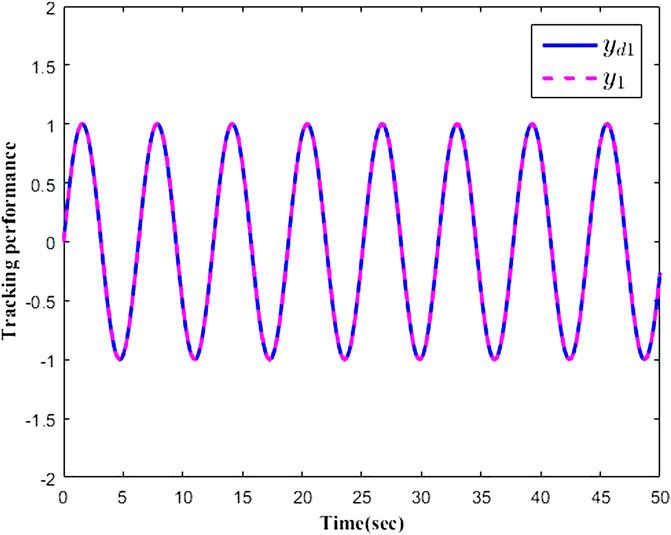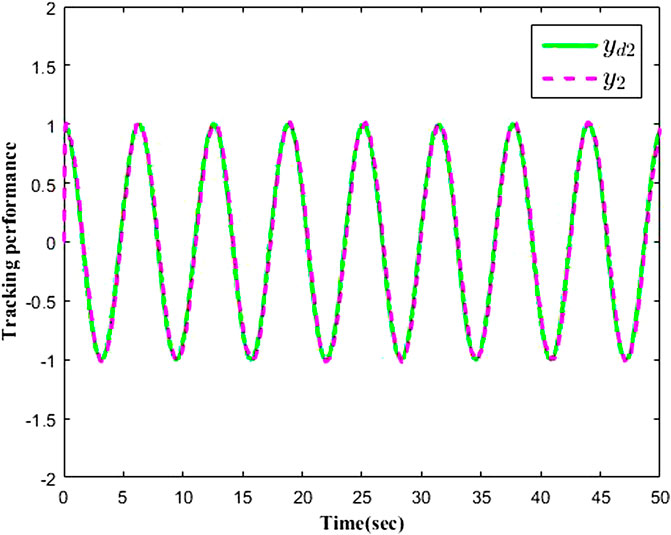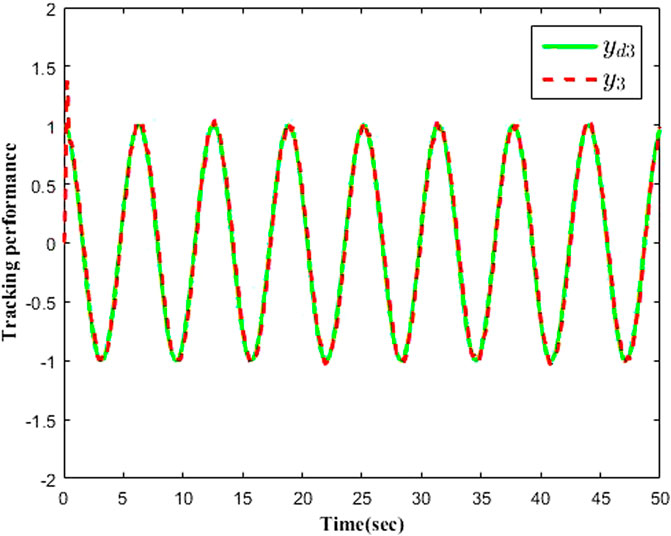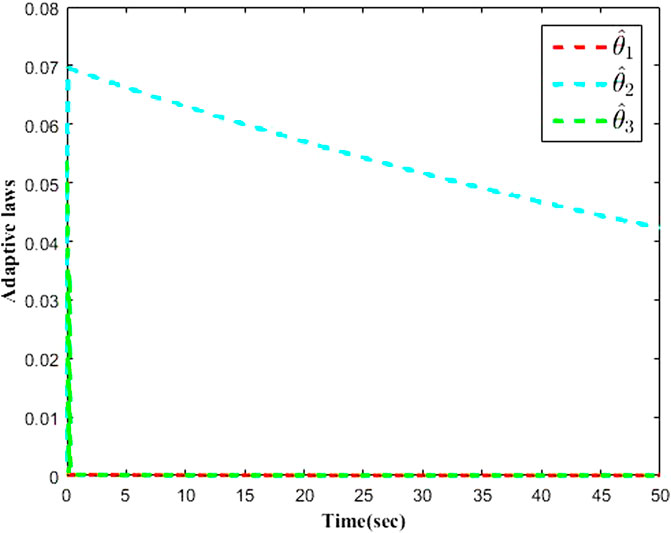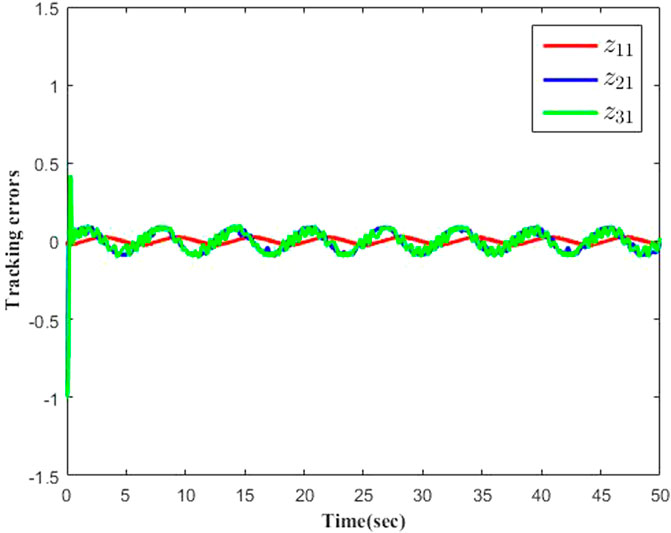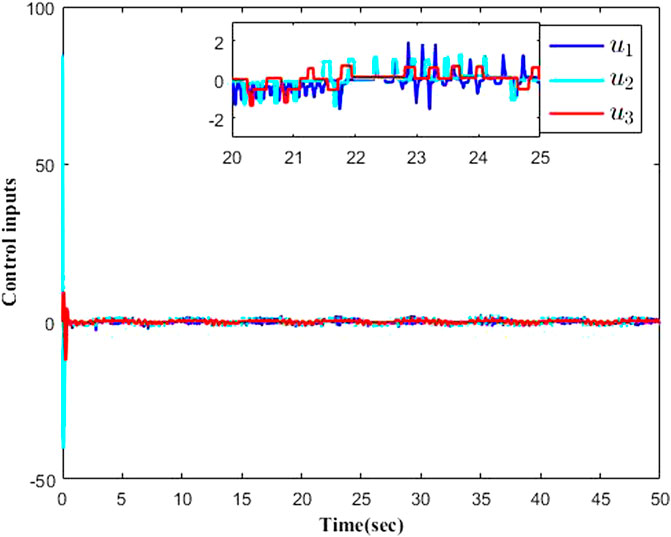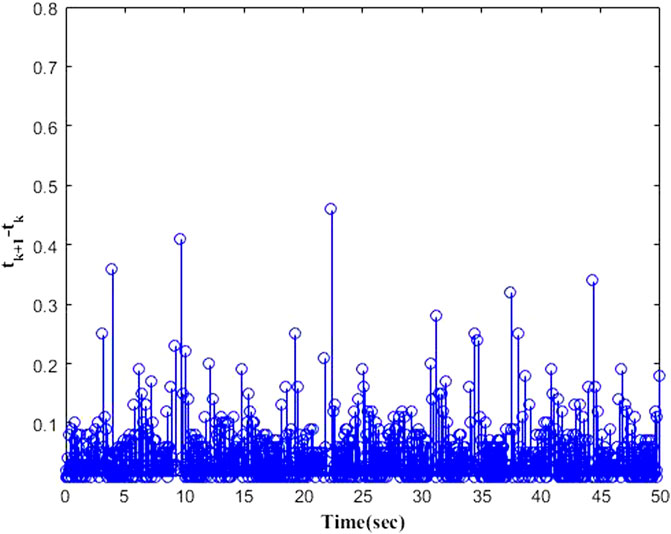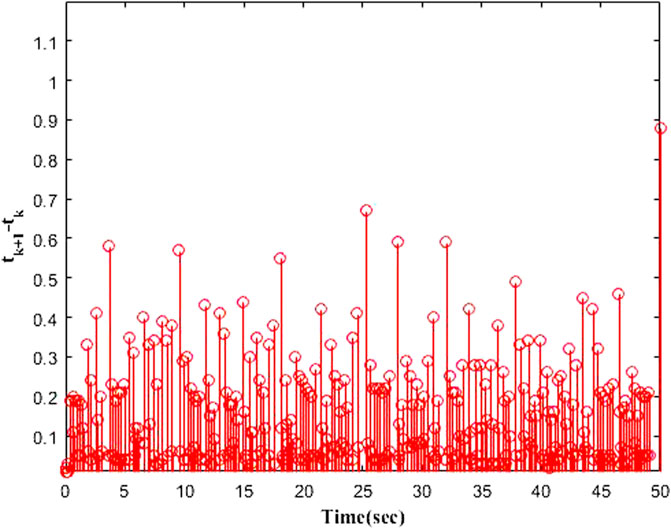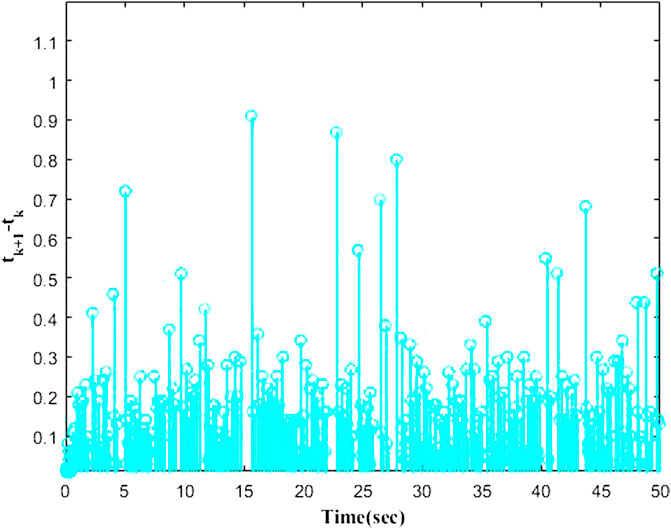- School of Information Science and Engineering, Shandong Normal University, Jinan, China
In this work, the issue of event-triggered-based asymptotic tracking adaptive control of stochastic nonlinear systems in pure-feedback form with strong interconnections is considered. First, a new decentralized control scheme is developed by introducing the new types of Nussbaum functions, which enables the output of each subsystem to asymptotically track the desired reference signal. Second, the nonaffine structures and the unknown control gains existing in the nonlinear systems are a part of the considered system model, which makes it more complicated to design the decentralized controllers. Therefore, the complexity caused by the nonaffine structures is faciliated by mean value theorem and the unknown control gains are handled by a novel Nussbaum function in our proposed design scheme. Meanwhile, the unknown nonlinearities of the system are approximated by using intelligent control technology. Furthermore, an event-triggered method is introduced in the design process to save communication resources effectively. It is shown that all signals of the closed-loop systems are bounded in probability and the tracking errors asymptotically converge to zero in probability. Finally, the simulation results illustrate the effectivity of the presented scheme.
1 Introduction
Stochastic external disturbances exist in many branches of science and industry such as unmanned air vehicles, intelligent home and distributed networks [1,2]. Seeing that stochastic nonlinear systems can model a mass of artificial or physical industrial platforms with stochastic external disturbances, it is necessary and beneficial to study them for the vast majority of researchers [3–5]. Recently, stability control of stochastic nonlinear systems with strict feedback or nonstrict feedback form has been the hot topic discussed by many researchers. Nevertheless, most of actual models do not satisfy strict-feedback and nonstrict-feedback form [6–9]. Therefore, numerous researchers have devoted themselves to the study of adaptive controller design for stochastic nonlinear systems in pure-feedback form such as mechanical and electrical systems, biochemical medical systems, and dynamic model systems in pendulum control. More researches on stochastic nonlinear systems with nonaffine structures have been explored, which were considered as complex and challenging themes such as state constraint, adaptive control, and output-feedback control. In [8], the finite-time tracking control problem was addressed for stochastic pure-feedback nonlinear systems by introducing the barrier Lyapunov functions, the mean value theorem, and the adaptive neural networks.
Furthermore, the interconnected systems composed of several subsystems are called large-scale systems. The large-scale systems have been extensively investigated because of their countless applications in power systems, mobile satellite communication systems, and multiagent systems. However, different from the existing literature [10,11], the interconnection terms of strongly interconnected nonlinear systems contain all the state variables of the other subsystems. There is no doubt that the design of the centralized controller of large-scale systems is difficult due to the existence of physical communication limitations among subsystems. Therefore, the decentralized control scheme was proposed in order to achieve the desired control goal of large-scale systems. For uncertain interconnected systems with dynamic interactions [10], presented a new decentralized adaptive backstepping-based control algorithm to deal with discontinuity caused by state-triggering. In [11], the decentralized event-triggered fault-tolerant control (FTC) scheme was proposed for the interconnected nonlinear systems with unknown strong coupling and actuator failures. Different from the centralized control, decentralized control not only mitigates computation burden, but also strengthens robustness of systems. Simultaneously, since event-triggered control (ETC) strategy can effectively reduce resources waste of unnecessary communication, it has become an attractive research orientation. The ETC strategy is that the control signal does not change in real time, but is restricted by the trigger condition. It only changes at the moment of trigger and remains stable within the trigger interval. So far, many meaningful results on ETC strategy have been obtained [12–14]. For asymptotic tracking of uncertain nonlinear systems [13], a novel adaptive event-triggered control framework was proposed to reduce the communication burden. Furthermore, the adaptive event-triggered tracking control problem was considered by relaxing the feasibility condition of the intermediate virtual controller for a class of stochastic nonlinear systems [14]. Although the ETC strategy has been employed to diversified nonlinear systems in aformentioned results, the ETC mechanism based on relative threshold for stochasitc interconnected pure-feedback nonlinear systems are yet to be investigated.
Moreover, the issue of adaptive control for nonlinear systems with stochastic disturbances has attracted extensive attention from innumerable scholars [15,16]. On the one hand, neural networks (NNs), which is identified as a powerful tool to approximate unknown nonlinearities, has been extensively used in the adaptive control. On the other hand, how to deal with the control gain of stochastic nonlinear systems is also a concern. As we all know, compared with the bounded and stable characteristics of stochastic nonlinear systems, how to realize asymptotic tracking control has more practical significance and research value. Therefore, a new type of Nussbaum function is applied to the adaptive controller design, which makes the nonlinear systems realize asymptotic tracking and eliminates the influence of the unknown control gains [17]. So far, although remarkable results have been obtained in the research of stochastic nonlinear systems by using Nussbaum function, there exist few results about how to construct event-triggered-based adaptive controllers for stochastic systems with nonaffine structures and strong interconnection terms, which motivates us for this study.
In this paper, an event-triggered based adaptive decentralized asymptotic tracking control scheme is proposed for stochastic nonlinear systems with nonaffine structures and strong interconnection terms. The main contributions of this work are three-fold: 1) One thing that needs to be stressed is that it is very complicated to design decentralized controllers for interconnected systems, especially for the interconnected systems with both stochastic terms and nonaffine structures. Thus, a new decentralized control scheme is first developed by introducing the new type of Nussbaum functions, which realizes the asymptotic tracking control in probability for stochastic interconnected pure-feedback systems. 2) Meanwhile, how to save the system-limited transmutation resource for nonlinear systems, especially for uncertain stochastic interconnected pure-feedback systems is also a crucial issue. Therefore, the ETC strategy based on relative threshold is developed and only an adaptive law needs to be designed for each n-order subsystem, which greatly conserves the communication resources. 3) The interconnected terms in the nonlinear systems considered are associated with all state variables, which makes the traditional decentralized control method unavailable. Hence, to solve the problem, a decentralized control scheme using variable separation technique is presented.
2 System description and preliminaries
Consider a stochastic nonlinear system:
where ω is standard Wiener process; x ∈ Rn is the system state, fu: Rn → Rn and hs: Rn → Rn×r are locally Lipschitz functions. Next, some necessary definitions are introduced into this paper.
Definition 1 [18]: Combining with the differential Eq. 1, for any given
Definition 2 [18]: If the equality
The stochastic interconnected pure-feedback nonlinear systems are described as:
where
According to the properties of the mean value theorem [19], there must exist
where Φi,j and
The control objective of this paper is to design decentralized adaptive controllers for system 3) so that the tracking errors between system outputs and reference signals asymptotically converge to zero in probability and all the signals are semiglobally uniformly ultimately bounded in probability. To realize the desired control objective, some lemmas and assumptions are showed below.
Assumption 1: The functions Φi,j (i = 1, … , N, j = 1, … , ni) are bounded; there exist positive constants ςm and ςM such that
Assumption 2: The desired reference trajectories are represented as
Assumption 3 [20]: There are strict increasing smooth functions
Remark 1: If ar⩾0, for r = 1, … , ni,
Assumption 4 [21]: There are strict increasing smooth functions
Remark 2: Apparently, there exist smooth functions
where br⩾0.
Lemma 1 [22]: The Nussbaum function is given as
Lemma 2 [23]: For the form of the dynamic system
Lemma 3 [24]: For any
where ɛ > 0, pc > 1, qc > 1, and
Lemma 4 [25]: For any ϖ ∈ R and ɛ > 0, one has
In this work, the radial basis function neural networks (RBFNNs) will be employed to estimate the unknown nonlinear functions
where Z ∈ Rq denotes input vector of the RBFNNs and q represents the dimension of the RBFNNs input. The estimation error is represented as
where
Lemma 5 [26]: Consider a class of Gaussian function as basis function. Let
In this section, the controllers design procedure based on the backstepping will be presented. The RBFNNs will be used to estimate the unknown nonlinearities. In addition, the virtual control signals and the adaptive laws are designed as follows:
where ki,j, ai,j, γi, and σi are positive design parameters and
Lemma 6 [27]: According to the variables transformation zi,j = xi,j − αi,j−1, the strong interconnected term result can be obtained
where d* being the sum of upper bound of ydi,
3 Main result
For the sake of convenience, the state vector
Step i, 1: Based on zi,1 = xi,1 − ydi, zi,2 = xi,2 − αi,1, the derivative of zi,1 is given by
The Lyapunov function candidate Vi,1 is selected as
where γi > 0 is a positive constant and
Differentiating Vi,1 yields
By applying Assumption 3, 5), 7) and 14), we have
where
Then, Lemma 4 is employed to Ki,1 yields
By using Assumption 4 and (6)–(14), we can obtain
where li,1,1 is a positive constant and
Submitting (18)–(20) into (17), we get
Step i, j: Define zi,j = xi,j − αi,j−1 (2⩽j⩽ni − 1), one can get the derivative of zi,j
Next, the Lyapunov function Vi,j is designed as
By applying Assumptions 3, 4 and (5)–(14), one has
where for k = 1, 2, … , j,
By using Lemma 4, one obtains
Next, we further obtain
where for k = 1, 2, … , j, li,j,k are positive constants,
It follows from (Eqs 22–27) that
Step i, n: Based on
Next, consider a Lyapunov function as
Repeating the same derivations as (25) and (27) yields
where for k = 1, 2, … ni,
Combining with the whole design procedures from Step 1 to Step ni, choose Lyapunov function for the ith subsystem as
Thus, the Lyapunov function of the nonlinear systems is designed as
Next, utilizing (21) (28), and (32), one obtains
where
By rearranging sequence for above terms, we have
By utilizing the adaptive laws (12), above rearranging sequence, and Lemma 5, the second-to-last term in (Eq. 35) is further handled, one has
Next, for j = 1, 2, … , ni − 1, based on Assumption 1 and Lemma 3, we can obtain
Then, from (Eqs 39–43), Eq. 35 can be rewritten as
where
The approximation ability of RBFNNs is applied to
where
In addition, we can obtain below inequalities by using Young’s inequality
where
Based on above overall backstepping design procedures, we construct the virtual controllers for ith subsystems as
where ei(t) = wi(t) − ui(t) denote errors. ki,j, Pi,j, 0 < β < 1, ϕ, mi > 0, and
Thus, the controllers can be chosen as
Then, by substituting Eqs 50–54 into Eq. 44, one has
where
Next, substituting the designed controllers and Eq. 56 into Eq. 55, we have
where
Furthermore, according to the inequality
where
Theorem 1: Consider the stochastic interconnected nonlinear systems in pure-feedback form (Eq. 3), the adaptive laws (Eq. 13), the virtual controllers (Eqs 53, 54), and the actual control inputs (Eq. 55) based on Assumptions Eq. 1-4 are obtained. Above design procedures ensure that the signals of closed-loop remain semiglobally uniformly bounded in probability and zi,1 is asymptotically converge to zero in probability. In addition, the tracking error zi,j converge to compact set ΩZ, which is defined as
where c = min{4ki,j, σi, i = 1, 2, … , N, j = 1, 2, … , ni},
Proof: Based on above design parameters
holds for ∀t⩾0. According to (12) and Lemma 2,
where
Furthermore, one obtains
such that zi,j remain bounded for i = 1, 2, … , N, j = 1, 2, … , ni. Based on Eq. 63, we can conclude that zi,j eventually converge to compact set ΩZ. Moreover, from Eqs 50, 51 and
Hence, taking the integration of Eq. 64, we have
As a result,
The proof is finished.
Finally, for relative threshold ETC strategy, the Zeno phenomenon is a problem that must not be ignored. Therefore, there is a
We can know that wi(t) is bounded due to the existence of bounded variable signals. Consequently, it can be realized that wi(t) are smooth functions, thus
Remark 3: The previous analysis shows that the stability of the researched systems depends on the design parameters ki,j, ai,j, γi, ɛi,j and σi (i = 1, 2, … , N; j = 1, 2, … , ni). By adjusting parameters ɛi,j, ai,j, σi, γi to make the term D in Eq. 63 relatively small, and adjusting parameters ki,j, σi to make the term c in Eq. 63 relatively large. Then the proposed control strategy can ensure the stability of the closed-loop system.
4 Simulation example
At this section, the simulation results of the stochastic interconnected pure-feedback systems including three subsystems show effectiveness of the control scheme
In simulation, the design parameters are defined as follows: γ1 = 1, γ2 = 1, γ3 = 1, σ1 = 0.1, σ2 = 0.01, σ3 = 0.1, a1,1 = 0.01, a1,2 = 0.01, a2,1 = 2, a2,2 = 1, a3,1 = 0.1, a3,2 = 0.5, P1,1 = 0.01, P1,2 = 0.01, P2,1 = 0.001, P2,2 = 0.001, P3,1 = 1, P3,2 = 1, k1,1 = 7, k1,2 = 12, k2,1 = 6, k2,2 = 8, k3,1 = 5, k3,2 = 1, β = 0.1, ϕ = 0.5,
The simulation results are presented in Figures 1–9 by using the Matlab routine. Figures 1–3 show output signals y1, y2, y3 and desired signals yd1, yd2, yd3 respectively. As shown in Figures 1–3, the results demonstrate favourable tracking performances. Figure 4 shows the curves of adaptive laws
5 Conclusion
This paper has proposed the event-triggered-based asymptotic tracking control scheme for a class of uncertain stochastic interconnected nonlinear systems in pure-feedback form. The effect caused by the unknown control gains and the nonaffine structures have been eliminated by using the new types of Nussbaum functions and the mean value theorem, respectively. Then, the decentralized controllers have been constructed to achieve desired tracking performance. Furthermore, it has been proved that the proposed controllers guarantee that all signals remain bounded in probability. The simulation example illustrates the effectivity of the proposed scheme. In future, we intend to extend the proposed scheme to multi-agent stochastic nonlinear systems with malicious attacks.
Data availability statement
The original contributions presented in the study are included in the article/Supplementary material, further inquiries can be directed to the corresponding author.
Author contributions
YG, CL, ZG, BN, and BZ contributed the idea and design of the study. YG wrote the first draft of the manuscript. YG organized the literature. CL and ZG performed the design of figures. BN and BZ verified the experimental design. All authors contributed to the article and approved the submitted version.
Conflict of interest
The authors declare that the research was conducted in the absence of any commercial or financial relationships that could be construed as a potential conflict of interest.
Publisher’s note
All claims expressed in this article are solely those of the authors and do not necessarily represent those of their affiliated organizations, or those of the publisher, the editors and the reviewers. Any product that may be evaluated in this article, or claim that may be made by its manufacturer, is not guaranteed or endorsed by the publisher.
References
1. Shang Y, Chen B, Lin C. Consensus tracking control for distributed nonlinear multiagent systems via adaptive neural backstepping approach. IEEE Trans Syst Man, Cybernetics: Syst (2018) 50:2436–44. doi:10.1109/tsmc.2018.2816928
2. Xie X, Duan N. Output tracking of high-order stochastic nonlinear systems with application to benchmark mechanical system. IEEE Trans Automatic Control (2010) 55:1197–202. doi:10.1109/tac.2010.2043004
3. Li L, Fan M, Xia Y, Zhu C. Recursive distributed fusion estimation for nonlinear stochastic systems with event-triggered feedback. J Franklin Inst (2021) 358:7286–307. doi:10.1016/j.jfranklin.2021.07.036
4. Ma H, Zhou Q, Bai L, Liang H. Observer-based adaptive fuzzy fault-tolerant control for stochastic nonstrict-feedback nonlinear systems with input quantization. IEEE Trans Syst Man, Cybernetics: Syst (2018) 49:287–98. doi:10.1109/tsmc.2018.2833872
5. Liu H, Li X, Liu X, Wang H. Backstepping-based decentralized bounded-h adaptive neural control for a class of large-scale stochastic nonlinear systems. J Franklin Inst (2019) 356:8049–79. doi:10.1016/j.jfranklin.2019.06.043
6. Wang H, Zou Y, Shan L (2017). Adaptive fuzzy control of pure-feedback stochastic nonlinear systems with hysteresis. In Proceedings of the 2017 4th International Conference on Information, Cybernetics and Computational Social Systems (ICCSS) Dalian, China, July 20147 91–5.
7. Niu B, Duan P, Li J, Li X. Adaptive neural tracking control scheme of switched stochastic nonlinear pure-feedback nonlower triangular systems. IEEE Trans Syst Man, Cybernetics: Syst (2019) 51:975–86. doi:10.1109/tsmc.2019.2894745
8. Liu Y, Zhu Q. Adaptive neural network finite-time tracking control of full state constrained pure feedback stochastic nonlinear systems. J Franklin Inst (2020) 357:6738–59. doi:10.1016/j.jfranklin.2020.04.048
9. Niu B, Li H, Qin T, Karimi HR. Adaptive nn dynamic surface controller design for nonlinear pure-feedback switched systems with time-delays and quantized input. IEEE Trans Syst Man, Cybernetics: Syst (2017) 48:1676–88. doi:10.1109/tsmc.2017.2696710
10. Zhang Z, Wen C, Zhao K, Song Y. Decentralized adaptive control of uncertain interconnected systems with triggering state signals. Automatica (2022) 141:110283. doi:10.1016/j.automatica.2022.110283
11. Xu L, Wang Y, Wang X, Peng C. Decentralized event-triggered adaptive control for interconnected nonlinear systems with actuator failures. IEEE Trans Fuzzy Syst (2022) 31:148–59. doi:10.1109/tfuzz.2022.3183798
12. Hu X, Li Y, Hou Z. Event-triggered fuzzy adaptive fixed-time tracking control for nonlinear systems. IEEE Trans Cybernetics (2020) 52:7206–17. doi:10.1109/tcyb.2020.3035779
13. Li Y, Hu X, Che W, Hou Z. Event-based adaptive fuzzy asymptotic tracking control of uncertain nonlinear systems. IEEE Trans Fuzzy Syst (2020) 29:3003–13. doi:10.1109/tfuzz.2020.3010643
14. Wang T, Wang N, Qiu J, Buccella C, Cecati C. Adaptive event-triggered control of stochastic nonlinear systems with unknown dead zone. IEEE Trans Fuzzy Syst (2022) 31:138–47. doi:10.1109/tfuzz.2022.3183763
15. Song Y, Zhao K, Krstic M. Adaptive control with exponential regulation in the absence of persistent excitation. IEEE Trans Automatic Control (2016) 62:2589–96. doi:10.1109/tac.2016.2599645
16. Wang H, Liu PX, Bao J, Xie X-J, Li S. Adaptive neural output-feedback decentralized control for large-scale nonlinear systems with stochastic disturbances. IEEE Trans Neural networks Learn Syst (2019) 31:972–83. doi:10.1109/tnnls.2019.2912082
17. Chen C, Liu Z, Xie K, Liu Y, Zhang Y, Chen CP. Adaptive fuzzy asymptotic control of mimo systems with unknown input coefficients via a robust nussbaum gain-based approach. IEEE Trans Fuzzy Syst (2016) 25:1252–63. doi:10.1109/tfuzz.2016.2604848
18. Liu S-J, Zhang J-F, Jiang Z-P. Decentralized adaptive output-feedback stabilization for large-scale stochastic nonlinear systems. Automatica (2007) 43:238–51. doi:10.1016/j.automatica.2006.08.028
19. Ge SS, Wang C. Adaptive nn control of uncertain nonlinear pure-feedback systems. Automatica (2002) 38:671–82. doi:10.1016/s0005-1098(01)00254-0
20. Chen B, Liu XP, Ge SS, Lin C. Adaptive fuzzy control of a class of nonlinear systems by fuzzy approximation approach. IEEE Trans Fuzzy Syst (2012) 20:1012–21. doi:10.1109/tfuzz.2012.2190048
21. Wang H, Chen B, Lin C. Approximation-based adaptive fuzzy control for a class of non-strict-feedback stochastic nonlinear systems. Sci China Inf Sci (2014) 57:1–16. doi:10.1007/s11432-013-4785-x
22. Chen C, Liu Z, Xie K, Zhang Y, Chen CP. Asymptotic fuzzy neural network control for pure-feedback stochastic systems based on a semi-nussbaum function technique. IEEE Trans Cybernetics (2016) 47:2448–59. doi:10.1109/tcyb.2016.2628182
23. Wang M, Zhang S, Chen B, Luo F. Direct adaptive neural control for stabilization of nonlinear time-delay systems. Sci China Inf Sci (2010) 53:800–12. doi:10.1007/s11432-010-0075-z
24. Deng H, Krstić M. Stochastic nonlinear stabilization—i: A backstepping design. Syst Control Lett (1997) 32:143–50. doi:10.1016/s0167-6911(97)00068-6
25. Polycarpou MM, Ioannou PA (1993). A robust adaptive nonlinear control design. In Proceedings of the 1993 American control conference 1365–9. New Orleans, LA, USA, June 1993
26. Kurdila A, Narcowich FJ, Ward JD. Persistency of excitation in identification using radial basis function approximants. SIAM J Control optimization (1995) 33:625–42. doi:10.1137/s0363012992232555
27. Wang H, Liu X, Liu K. Robust adaptive neural tracking control for a class of stochastic nonlinear interconnected systems. IEEE Trans Neural Networks Learn Syst (2015) 27:510–23. doi:10.1109/tnnls.2015.2412035
28. Yu X, Xie X. Output feedback regulation of stochastic nonlinear systems with stochastic iiss inverse dynamics. IEEE Trans Automatic Control (2009) 55:304–20. doi:10.1109/TAC.2009.2034924
Keywords: adaptive control, asymptotic tracking, event-triggered strategy, stochastic nonlinear systems, strong interconnections frontiers
Citation: Gao Y, Liu C, Guo Z, Niu B and Zhang B (2023) A novel nussbaum functions based adaptive event-triggered asymptotic tracking control of stochastic nonlinear systems with strong interconnections. Front. Phys. 11:1227713. doi: 10.3389/fphy.2023.1227713
Received: 23 May 2023; Accepted: 03 July 2023;
Published: 14 July 2023.
Edited by:
Duxin Chen, Southeast University, ChinaReviewed by:
Sanbo Ding, Hebei University of Technology, ChinaYuanxin Li, Liaoning University of Technology, China
Copyright © 2023 Gao, Liu, Guo, Niu and Zhang. This is an open-access article distributed under the terms of the Creative Commons Attribution License (CC BY). The use, distribution or reproduction in other forums is permitted, provided the original author(s) and the copyright owner(s) are credited and that the original publication in this journal is cited, in accordance with accepted academic practice. No use, distribution or reproduction is permitted which does not comply with these terms.
*Correspondence: Baoyi Zhang, emJ5c2RudUBzZG51LmVkdS5jbg==
 Yahui Gao
Yahui Gao Chaoda Liu
Chaoda Liu Zhihua Guo
Zhihua Guo Ben Niu
Ben Niu